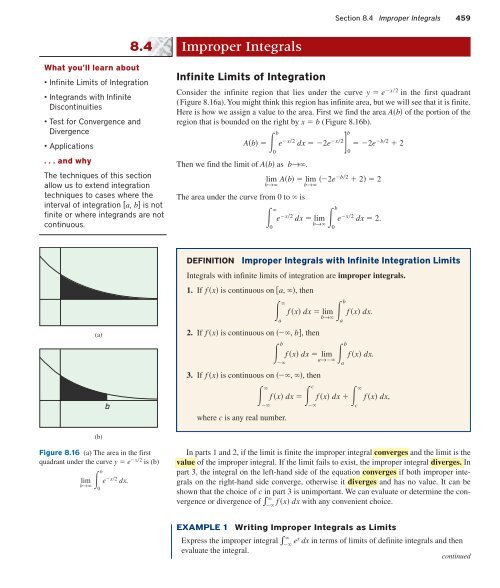You also want an ePaper? Increase the reach of your titles
YUMPU automatically turns print PDFs into web optimized ePapers that Google loves.
Section 8.4 Improper Integrals 459<br />
8.4<br />
What you’ll learn about<br />
• Infinite Limits of Integration<br />
• Integrands with Infinite<br />
Discontinuities<br />
• Test for Convergence and<br />
Divergence<br />
• Applications<br />
. . . and why<br />
The techniques of this section<br />
allow us to extend integration<br />
techniques to cases where the<br />
interval of integration [a, b] is not<br />
finite or where integrands are not<br />
continuous.<br />
Improper Integrals<br />
Infinite Limits of Integration<br />
Consider the infinite region that lies under the curve y e x2 in the first quadrant<br />
(Figure 8.16a). You might think this region has infinite area, but we will see that it is finite.<br />
Here is how we assign a value to the area. First we find the area Ab of the portion of the<br />
region that is bounded on the right by x b (Figure 8.16b).<br />
Ab x2]<br />
b<br />
b<br />
e x2 dx 2e 2e b2 2<br />
0<br />
Then we find the limit of Ab as b→.<br />
lim Ab lim<br />
b→ b→ 2eb2 2 2<br />
The area under the curve from 0 to is<br />
<br />
e x2 dx lim<br />
b→<br />
b<br />
e x2 dx 2.<br />
0<br />
0<br />
0<br />
(a)<br />
b<br />
DEFINITION<br />
Improper Integrals with Infinite Integration Limits<br />
Integrals with infinite limits of integration are improper integrals.<br />
1. If f x is continuous on a, , then<br />
<br />
a<br />
f x dx lim<br />
b→<br />
b<br />
2. If f x is continuous on , b, then<br />
b<br />
f x dx lim<br />
<br />
3. If f x is continuous on , , then<br />
where c is any real number.<br />
a<br />
a→ b<br />
a<br />
f x dx.<br />
f x dx.<br />
<br />
f x dx c<br />
f x dx <br />
f x dx,<br />
<br />
<br />
c<br />
(b)<br />
Figure 8.16 (a) The area in the first<br />
quadrant under the curve y e x2 is (b)<br />
lim<br />
b→ b<br />
0<br />
e x2 dx.<br />
In parts 1 and 2, if the limit is finite the improper integral converges and the limit is the<br />
value of the improper integral. If the limit fails to exist, the improper integral diverges. In<br />
part 3, the integral on the left-hand side of the equation converges if both improper integrals<br />
on the right-hand side converge, otherwise it diverges and has no value. It can be<br />
shown that the choice of c in part 3 is unimportant. We can evaluate or determine the convergence<br />
or divergence of f x dx with any convenient choice.<br />
<br />
EXAMPLE 1 Writing Improper Integrals as Limits<br />
Express the improper integral ex dx in terms of limits of definite integrals and then<br />
evaluate the integral.<br />
continued












